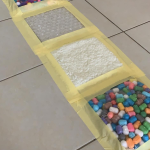Written by Rachel Taylor
Monday morning, your classroom is full and no one is happy to be there. James is crying. Abby is hitting Laseka. Darius is asleep.
And then there’s you. Underpaid and overworked.
But you love your kiddos. How can you turn this around?
In early childhood, we are sensory beings. Each sensation brings on a new way of understanding the world. The problem is, not all of these sensations are positive.
When Abby hit Laseka, Laseka was overwhelmed with pain sensations in her developing nervous system. When James felt wetness in his diaper, the itching was intense.
Here’s the good news: just like negative experiences can overwhelm these children, so can positive experiences overshadow the negative ones.[1]
On a teacher’s salary, that seems tricky. Who has the money to buy expensive childrens’ toys that target various sensory experiences? Whose program is going to pay for new expensive toys when you already have “plenty”?
More good news: sensory experiences do not have to be expensive! Below are some ways to develop sensory experiences on a budget.
12 Months and Under
 What you’ll need: Ziplock bags and craft items of various sizes/textures
What you’ll need: Ziplock bags and craft items of various sizes/textures
What to do:
1. Place the items in different bags.
2. Fill the bags half way and then seal.
3. Tape the bags to the floor and let the children explore.
For added sensory experiences, you can use:
● Noisemakers (dog toys, whoopee cushions, etc.)
● Ice cubes
● Scented lotion
● Snacks that crunch under their hands
Credit: KittyKertz on Pinterest
12 – 24 Months
 What you’ll need:
What you’ll need:
- Pom poms
- Toilet paper or paper towel cardboard roll
- Tape (preferably painters or masking tape)
- A wall
What to do:
- Tape the cardboard rolls to the wall to create a chute that kids can drop the pom poms down.
- Teach the kids to drop the pom poms down the chutes.
For added sensory experiences, you can use:
- Differently weighted objects
- Differently textured objects
- Ice cubes (but make sure you have a bowl below!)
- Light-up bouncy balls
Credit: Teaching Littles
24+ Months
 What you’ll need:
What you’ll need:
- Shaving cream
- Paint
- Paint brushes
- Plates
- Disposable placemat for easy cleaning
What to do:
- Fill each of the plates with shaving cream.
- Ask the children to pick 2 colors they want to paint with and place a dot of paint on either side of the plate.
- Encourage the kids to move the paint around and even mix the colors together to see that happens.
For added sensory experiences, you can use:
- Their fingers (be ready with some paper towels and a sink to wash their hands in)
- Scented paint or essential oils in the shaving cream
- Objects (pasta, beans, etc.) hidden in the shaving cream
- Whipped cream with food coloring or colored frosting for adding taste sensation
Credit: Fun with Mama
Whatever activity you choose, giving your kids a positive, multi-sensory experience can calm their developing nervous systems and promote sensory development.
And remember, even when all your kiddos are having a bad day, you’re doing a great job!
We are here to help. Want to learn more about managing disruptive behaviors? Check out our class on Treating Toddler Tantrums:
[1] “Chapter 4: Infancy: Early Learning, Motor Skills, and Perceptual Capacities .” Child Development, by Laura E. Berk, 9th ed., Pearson, 2013, pp. 128–173.

